|
Northwood - good night out with wine, women and
song?
In 1829 William Ridgeway of Northwood attracted a new community to an area of land that reached from Town Road along Keelings Lane to the old Bucknall Road. A contemporary writer in praise of Ridgeway commented, “This is now a clean and desirable district that has seen good changes emerge from a rude demoralised part of Hanley into a beautifully well-organised
hamlet.”

Originally William
Ridgeway's home - called Prospect House
Google Street View
It was Ridgeway who single-handedly cleared out the riff-raff, demolished their ‘unsightly cottages’ and erected a row of substantial houses, a school and a few almshouses for ‘decaying widows.’ Just what it was like before Ridgeway arrived we can’t guess but it couldn’t have been half as bad as how it turned out by the middle of the 19th century.
In the month of May in 1867 there were 36 deaths alone of scarlet fever and in the same years 20 residents succumbed to smallpox. Northwood became a place of ill-repute, a village where Hanley lads would venture for a good night out with wine, women and song. Mind you there were enough public houses to sink the proverbial battleship – there were fifteen – almost one for each head of the household. So, what was it that attracted all this low life to Ridgeway’s ‘clean and desirable district?’
In 1850 the population of Northwood was 3,300 mostly made up of pottery workers. It stretched from Providence Square along Keelings Lane through Upper Green, skirting Birches Head along to Far Green – old names that have lost their meaning.
The district used to have its own constable, but the job became so dangerous that policemen had to patrol in pairs. One of the most popular constables was ‘Bobby’ Shenton. It was said that it he could look after himself very well if you please; but his popularity came from being able to look the other way when indiscrete behaviour might otherwise bring him into conflict with his neighbours.
One part of Northwood which achieved notable infamy was West Street which lay in an area below a few yards of derelict land called ‘The Rocks’ bordering on Eastbourne Road; today it is a familiar and pleasant boulevard alongside the public park. It was here that women of ill-repute gathered on the Sabbath to ply their trades which was a magnet for the local Hanley lads and rough clients. These were ‘shilling women’ who charged even less when beer fired them.
It was claimed by the constabulary that the Northwood women were far more deadly than the Northwood men in the course of regular street fights usually over money, payment in kind, jealousy and spite.

In 1960 an old resident of Northwood recalled a living-memory tale for the interest of the late historian Ernest Warrillow. The story went that a policeman, new to the beat, followed a group of screaming and fighting women into a terraced house where the disturbance continued amid the sound of breaking glass and splintering furniture. A large crowd had gathered on the pavement to witness the fun when, after a few minutes, a window was thrown open and the poor rookie was bundled naked into the street followed by his bundled-up uniform, his boots and his helmet.
This of course was not a commonplace occurrence but Arthur Coxon, whose father ran a scrap business in Oak Street, remembers his dad’s scrap-yard being very popular with police. At first Arthur thought it was part of the routine dealings with police examining the log records and checking the site for the possibility of finding stolen goods. But he soon realised that his dad had a special relationship with the detectives.
“Most days the old coppers would call round and disappear into the office for an hour at a time. Then they’d come out and I could tell at an instance that other business had occurred. They seemed happier and friendlier than when they’d arrived. And I’d notice that the whisky bottle, which my father always kept to hand for medicinal purposes, had certainly been applied to its fullest extent as a remedy for whatever ailments the coppers had brought with them. The bottle was nearly always empty after the detectives had left. It gives a whole new meaning to the expression – Good Health! Mind you it was in the Cat Inn that most business was done, whether by the police or
criminals.”
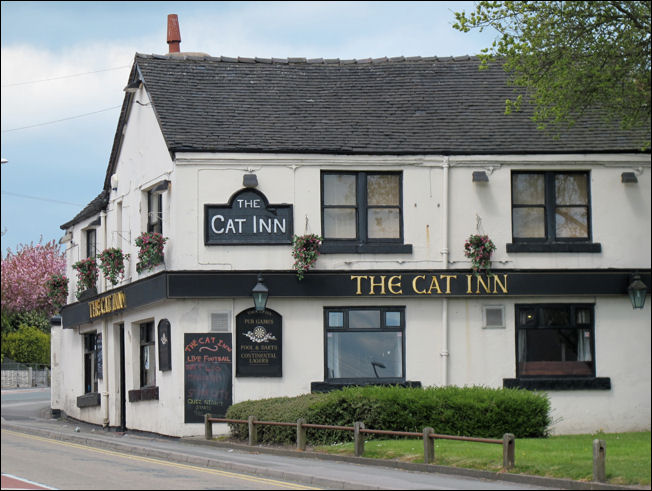
The Cat Inn
- Keelings Road, Northwood
The Cat Inn in Keelings Road is indeed an ancient inn. While the other 15 pubs in Northwood arrived as a result of beer-house legislation in 1830’s the Cat Inn has been there long before that. In fact it is well attested that men would turn out for a round of cock fighting from the end of the 18th century until well into Victorian times. Arthur remembers the comings and goings at the Cat in the 1940’s.
“You could probably buy anything in the Cat for the right price and no questions asked nor answers expected. There was a scruffy bloke who’d come round with a dirty sack and tip out seven or eight joints of beef on the bar. Filthy and black as coal they were. But my father would always buy one for a shilling to take home for the weekend. Mother would wash all the dirt off and come Sunday it tasted lovely roasted with all the trimmings. Of course in those days meat was very scarce. I remember sometimes my mother would stuff a butterfly’s heart and carve it up with lettuce for sandwiches.”
My jaw drops. But the twinkle in Arthur’s eye alerts me to the ruse – that he was slightly over-egging the story – but perhaps that’s how it really was; in those days you got what you could get and took whatever passed you by.
Ann and Ken Shaw have lived in Lower Mayer Street for 46 years. They brought up their family of three there, now it’s their grandchildren’s turn.
“One thing I can say definitely,” says Ann, “Northwood is a very close-knit community.” Ann should know after all she has represented the district on the council for twenty years. Coming from a family deep-rooted in the Coop movement and Labour – her mother and father were Labour stalwarts Lucy and Harry Smallwood – she has visited every house in the locality, not once but every year since she cares to remember.
“There are some out-of-the-way streets,” she confides, “places I would not ordinarily visit. But the people of Northwood’s posh houses and the working class cottages in the terraced streets have mixed well over the years. Just down the road, around the corner from Eastbourne Road were a group of old almshouses until recent times known as Widow’s Row. These were houses built when the Ridgeway family lived here by the Ridgeways. It was Ridgeway’s idea to build a new community, and it became a true socialist enterprise and I think it has lasted well,” says Ann.
The Ridgeway estate once surrounded the Ridgeway’s big house, part of which still remains as the Northwood Hotel which
William Ridgeway originally called Prospect House. But one of the more outstanding buildings stands a little higher up the hill.

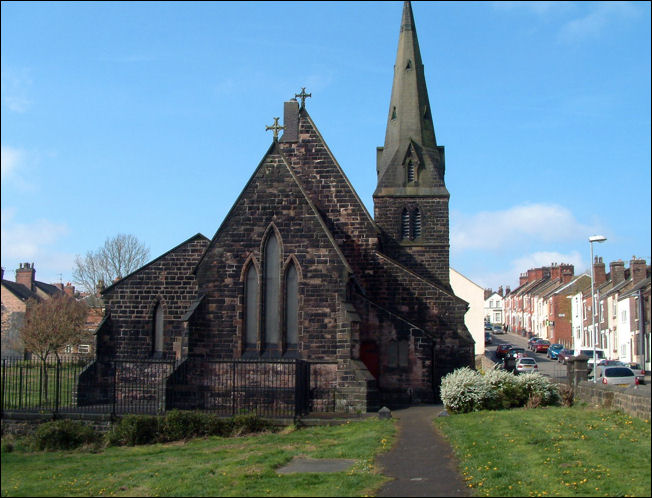
Holy Trinity Church,
Lower Mayer Street
Just below Ann and Ken’s house an unsuspecting wanderer will be amazed to come across the Holy Trinity church that wouldn’t be out of place at the centre of a rural English village next to a village green. Here it stands surrounded by row upon row of terraced back-to-backs built in 1848 to serve the growing community of rich merchants who eventually left for more distinguished climes over Trentham and Newcastle way. I suppose this was when community supervision broke down, I muse.
If there were a lot of pubs in Northwood it seems there were just as many places of worship. In Mayer Street there was the ‘Welsh Chapel.’ Although now demolished it was used in later years as a dance school by Beryl Cooper, a well-known Potteries dance tutor. And, according to Ann Shaw, it was in these halls that Anthea Turner acquired her dancing skills taught by the great
Beryl herself.
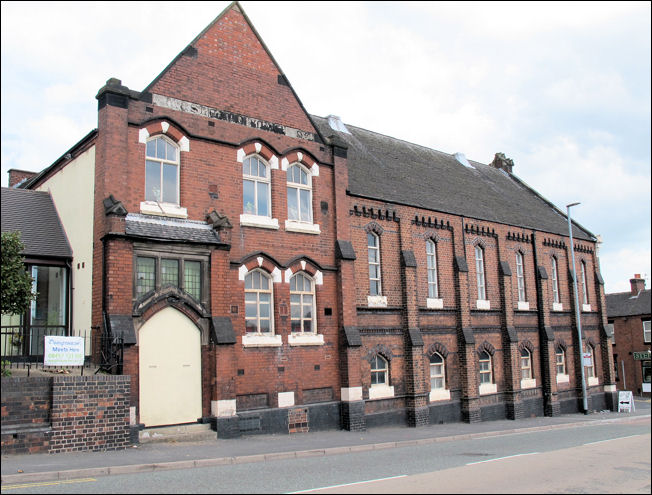
Wesleyan Methodist
Church, Keelings Road, Northwood
Two other places of worship, the church hall and chapel that stood in Mount Street and the Wesleyan Chapel still stand, and doing good business, here in Keelings Road.

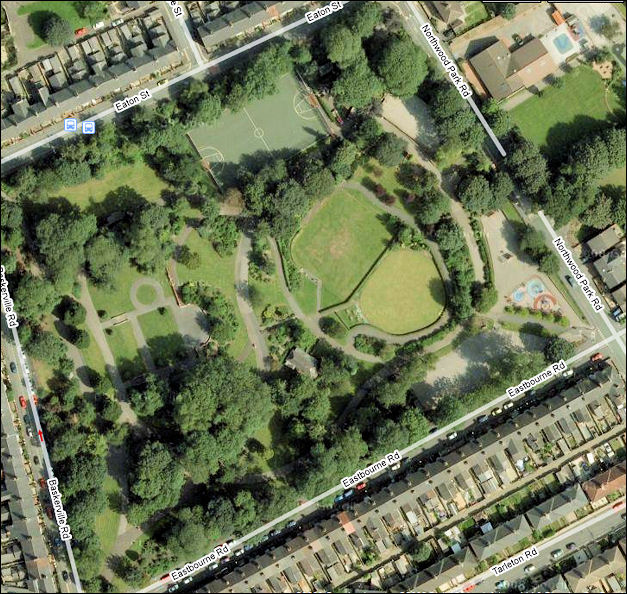
Northwood Park,
Hanley - Google Maps 2008
Northwood is a place that benefits from as many amenities any resident would want right on the doorstep of the City Centre – Hanley that is. In the 1910s the streets around Northwood Park were built complementing the 11 acres of parkland that opened in 1907 as part of the jubilee celebrations of Hanley’s incorporation as a county borough.
This delightful modern oasis was built on Ridgway’s land; in fact it was once the back garden of the family home, Prospect House. The contours of the park reflect the idyllic environment of a Georgian gentleman’s ancestral seat set on two levels following the western slopes of Hanley Green cascading from the ridge of St John Street.
“All these streets were home to the middle class merchants of Hanley,” says Ann Shaw. “Can you imagine the views from up there? It must have really been Nob Hill.”
Northwood then is a multifaceted settlement; a place of conflicting divisions where the rich found it expedient to get along with the poor – although they both knew their place. A place of crude terraced cottages set among grand residences of the rich.
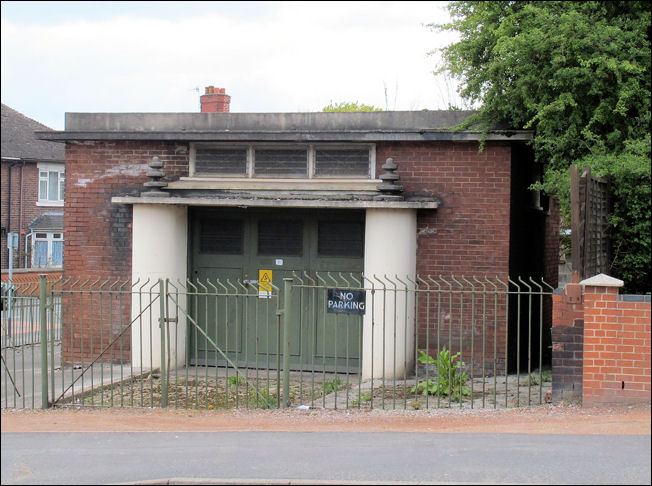
the Babylonian portico of the
electricity sub-station in Keelings Road
One jewel in Northwood’s crown often missed is the delightful Babylonian portico of the MEB sub-station in Keelings Road constructed with mock-ionic columns with a canopy capped with stone-carved electrical insulators. It’s a blend of art and industry and it is shamefully unlisted.
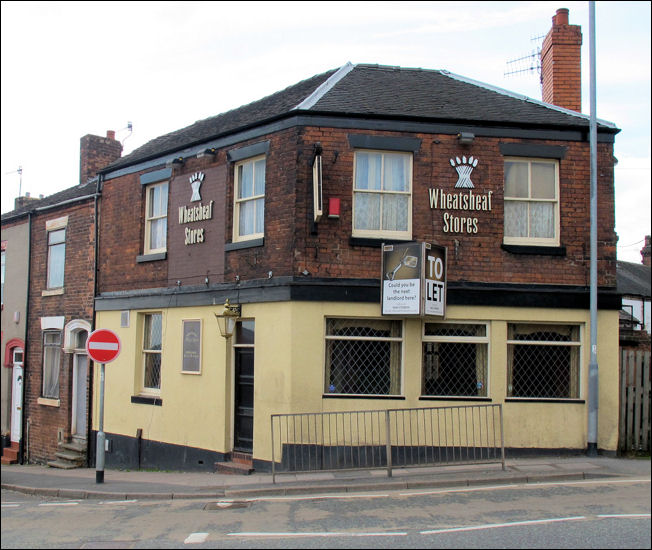
Wheatsheaf Stores,
Keelings Road
Meanwhile a cluster of shops and businesses squat around the Wheatsheaf Stores while the narrow terraced streets are filled with wonderfully-named pubs – Cross Guns and Cross Keys; Hollybushes and Albert Inns, where the ghosts of furtive men prowl carrying coal-dusty black sacks weighed down with handsome meals fit for the finest dinner tables.
Fred Hughes

|
![]()
![]()
![]()